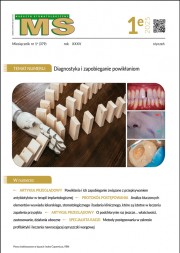Dostęp do tego artykułu jest płatny.
Zapraszamy do zakupu!
Po dokonaniu zakupu artykuł w postaci pliku PDF prześlemy bezpośrednio pod twój adres e-mail.
Comparative cephalometric evaluation of skeletal and dentoalveolar changes and measurement of degree of tooth mobility after treatment with Pendulum and Pendulum K appliances
Wprowadzenie. Jedną z metod leczenia wad klasy II, wynikających z przedwczesnej utraty zębów trzonowych mlecznych, jest dystalizacja pierwszych zębów trzonowych szczęki do klasy I wg Angle’a. Jednym z najczęściej stosowanych w tym celu aparatów jest Pendulum, zaprojektowany przez Hilgersa.
Cel pracy. Celem pracy była ocena cefalometryczna zmian szkieletowych i zębowo-wyrostkowych oraz pomiar stopnia ruchomości zębów aparatem Periotest M po leczeniu aparatani Pendulum i Pendulum K.
Materiał i metody. Materiał badany stanowiły 22 zdjecia cefalometryczne 11 pacjentów (7 dziewcząt, 4 chłopców) oraz pomiary wykonane aparatem Periotest M przed leczeniem i po leczeniu aparatami Pendulum i Pendulum K.
Wyniki i wnioski. W grupie leczonej aparatem Pendulum wielkość uzyskanego miejsca wyniosła 7 mm, a w grupie Pendulum K – 10 mm. Następstwem dystalizacji zębów trzonowych było rozchwianie zębów cofanych i kotwicowych. Przy wyborze aparatu należy brać pod uwagę możliwość większej utraty zakotwiczenia w obrębie zębów przedtrzonowych i siecznych w przypadku aparatu Pendulum K.
Introduction. One of the methods of treating Class II malocclusion arising from premature loss of deciduous molars is to distalyze the first maxillary molar to Class I (Angle). One of the most commonly used apparatus for this is the Pendulum, designed by Hilgers. Aim of study. The aim of the study was to make a cephalometric evaluation of skeletal and dento-alveolar changes and to measure the level of tooth mobility using the Periotest M apparatus after treatment with the Pendulum and Pendulum K appliances. Materials and methods. The material examined consisted of 22 cephalometric photographs of 11 patients (7 girls, 4 boys) and measurements made with the Periotest M before and after treatment with the Pendulum and Pendulum K appliances. Results and conclusions. In the group treated with the Pendulum the majority achieved space of 7 mm, and in the Pendulum K group of 10 mm. The consequence of the distalyzing of molars was a loosening of the teeth moved back and of the anchor teeth. Before choosing the appliance consideration should be made of the possibility of greater loss of anchorage in the region of the premolars and incisors in the case of the Pendulum K appliance.














